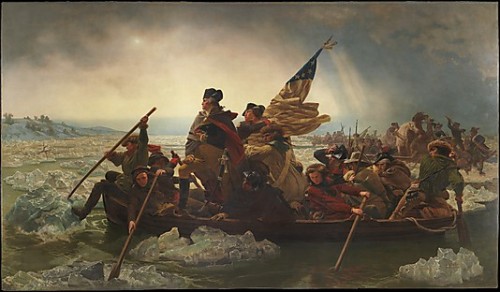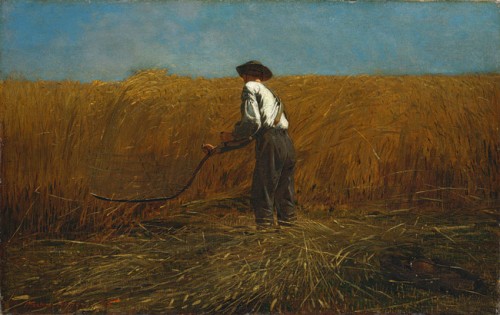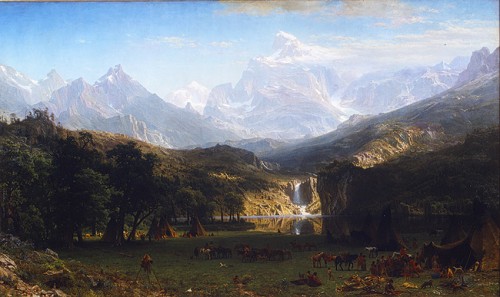
Emanuel Leutze. "Washington Crossing the Delaware," 1851. Oil on canvas. Metropolitan Museum of Art, NY.
As an art writer, I anticipate the Whitney Biennial as much as a kid does Christmas. Maybe twice as much because it comes half as often. But for some reason when it actually arrives I end up treating the spectacle more like Joan Rivers does the Oscars, with an institutional scrutiny and criticality that, assuming we’re all in this thing together, borders on masochism.
And I don’t think it’s just me; it seems like every other year in spring the entire art world grows claws and starts going after its own kind. Something about the pomp of the spectacle begs for extra institutional vigilance. It’s a corollary to my “Damien Hirst theory:” that critics build up hostility towards an artist until he or she is prominent enough to safely absorb the criticism, then they let loose. In the end the extra criticality is probably a good thing because the art world does a more-than-adequate job of avoiding self-sabotage for the majority of the time.
I think the other reason people are so inclined to take off the gloves every other March is that the Biennial, which claims to provide a “look at the current state of contemporary art in America,” is more a reflection of certain curatorial and institutional prerogatives than an objective survey. This has been especially true over the past decade. If anyone has any doubts about this, just ask its curators how many trips they made to America’s landlocked states in order to discover the talent hidden there. But no one ever said the path of cultural canonization was fair or logical, which is why this year I’m going to muzzle it. I plan to skip waiting in lines snaking around 75th Street and down Park Avenue and avoid the spectacle of the previews altogether. I’m going to wait until the end of May to see the Biennial, after the sniping has flattened, the crowds have dissipated, and the crates are being loaded for Basel.
In lieu of hitting the Biennial later this week to see the future of American art, I went to the Met today to see its venerable past. The Metropolitan Museum of Art recently unveiled the third phase of a massive renovation of its American art wing, and as someone who errs on the side of looking at current art when gallery hopping, it was a wonderfully necessary gut-check. There’s nothing wrong–in fact there’s a lot that is very right–about surveying the contemporary scene and taking its temperature, but seeing John Singer Sargent’s 1884 Madame X again calibrated my thermometers. It and other gems in the collection reminded me of the eternal in art; about the intangible stuff lurking below the radar of a moment in time, beyond the zeitgeists and the movements. Works like Thomas Cole’s Oxbow, Frederick Kensett’s Twilight on the Sound, Darien, Connecticut and Albert Pinkham Ryder’s eerie seascapes let us know that there is a thread sewn through the greatest works that transcends mere content and form. Winslow Homer’s post-Civil War classic Veteran in a New Field reminded me of the precariousness and resilience of the young States, and forced me to consider what I sometimes take for granted when I campaign for the avant-garde. Even the grandiosity of Albert Beirstadt’s Rocky Mountains impressed me as honest and profound, if in a chauvinistic kind of way.

Winslow Homer. "The Veteran in a New Field," 1865. Oil on canvas. 24 1/8 x 38 1/8 in. (61.3 x 96.8 cm). Metropolitan Museum of Art; bequest of Miss Adelaide Milton de Groot (1876–1967), 1967 (67.187.131).

Albert Bierstadt. "The Rocky Mountains, Lander's Peak," 1863. Oil on canvas. 73 1/2 x 120 3/4 in. (186.7 x 306.7 cm). Metropolitan Museum of Art; Rogers Fund, 1907 (07.123).
Then there’s that hulking, theatrical hood ornament of a painting by Emanuel Gottlieb Leutze, Washington Crossing the Delaware, that, even in its immodesty and pomposity somehow speaks a telling truth about American aspirations in the 19th century. Leutze, a German immigrant, helped to spin the American mythos and canonize George Washington, 75 years after he had already landed safely on the other side of the Delaware River. It makes you want to half sarcastically belt out a Lee Greenwood anthem. Sure, the painting takes liberties and pounds its chest a bit, but give it credit for waiting 75 years for the dust of history to settle before doing so. That’s more than we can say about some bi-annual art events.
Ok, that’s the last of the catty swipes I’ll take this year. I’m holding my breath and retracting my claws until 2014. There’ll be enough rancor, premature historicizing and gossip around this spring for me to sit this one out.
Instead, I’m going to save my venom for Joan Rivers as she lays into celebrities with poorly chosen outfits at the Oscars. The nerve. I think she could use a trip to the Anthology Film Archives.



